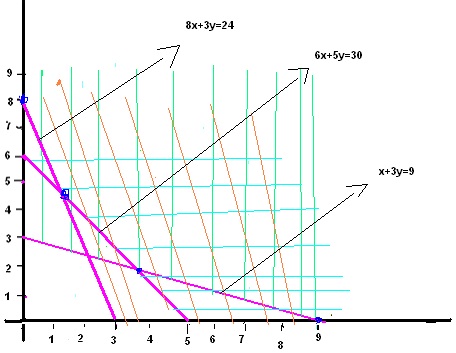Problems:
A cook is puzzling over the number of pounds of food he should purchase in order to minimize his cost. He has always bought his food from a small health food store in town. The store sells two types of mixtures. Both of these mixtures contain the three ingredients needed, but the cook needs his own special ratio of these ingredients to meet the requirements of a certain diet. The chart below shows that the diet is to be made up of at least 9 grams of Vitamin B-12, at least 30 grams of calcium, and at least 24 grams of iron. As the chart also shows the ratios for each of the three ingredients in the two mixtures the store sells is not the same as what the cook needs. The cook wants to minimize his costs, and have the minimum requirements met once he combines the two mixtures and cooks up the entire blend.
Dietary Constraints
|
|
|
Vitamin B-12
|
Calcium
|
Iron
|
|
Minimum Requirements
|
9 grams
|
30 grams
|
24 grams
|
|
Farmer's Mixture A
= $3.00 per pound
|
1 g per pound
|
6 g per pound
|
8 g per pound
|
|
Farmer's Mixture B
= $5.00 per pound
|
3 g per pound
|
5 g per pound
|
3 g per pound
|
1. First set up an equation for the total cost the cook will have to pay for the two mixtures he will buy. This will be called the cost function.
Let x = the number of pounds of Mixture A, and y = the number of pounds of Mixture B.
Cost Function min (z) = 3x+5y
2. Next, develop three inequalities utilizing the cook's dietary constraints.
x+3y >= 9
6x+5y >=30
8x+3y >= 24
3. Draw a graph for the solution of the three inequalities (this does not need to be turned in). Shading will indicate the solution to each inequality. In this case, since the wording of the inequalities was "at least" 9 grams of Vitamin B-12, etc., the inequalities will utilize the = symbol. The shaded area that satisfies all three inequalities will form a solution area bounded by the segments of straight lines.

Next, calculate the coordinates of each point in the solution area where any two of the boundary lines intersect, as well as where any of the boundary lines cross the axes.
a. 1st point of intersection is: (30/22, 96/22) - point of intersection of 8x+3y=24 and 6x+5y=30).
b. 2nd point of intersection is =( 45/13,24/13) - point of intersection of x+3y=9 and 6x+5y=30)
c. x-intercept is: (9,0)
d. y-intercept is. (0,8)
Explain how to obtain these.
Look for the region of intersection of all the lines (orange lines, green lines, blue lines)
The blue points indicated in the graphs are the required points of intersection
4. Calculate the cost at each of the points of intersection, including the intercepts. Then compare these values and pick the one that is the least.
a. The value of the cost function at the 1st point of intersection is:
b. The value of the cost function at the 2nd point of intersection is:
c. The value of the cost function at the x intercept is:
d. The value of the cost function at the y intercept is:
e. The cost is the least at: